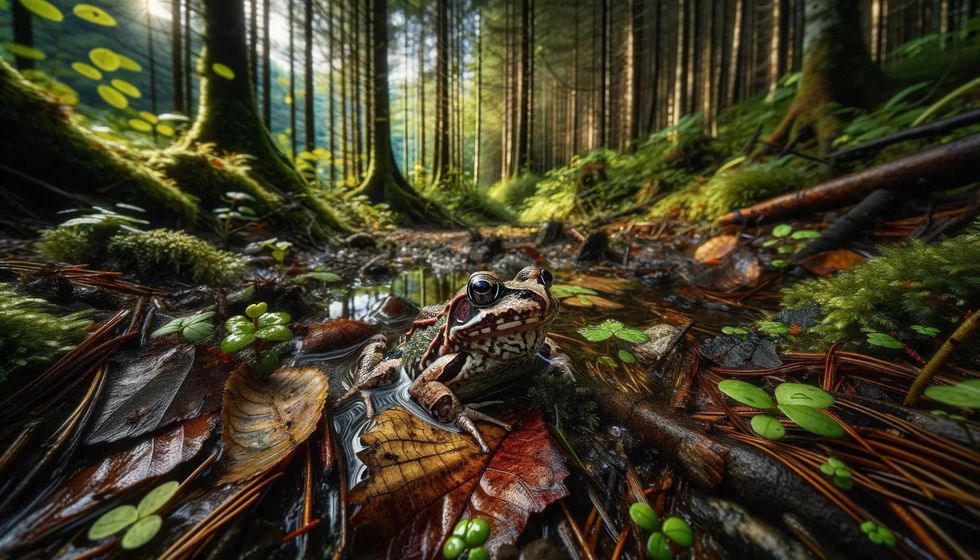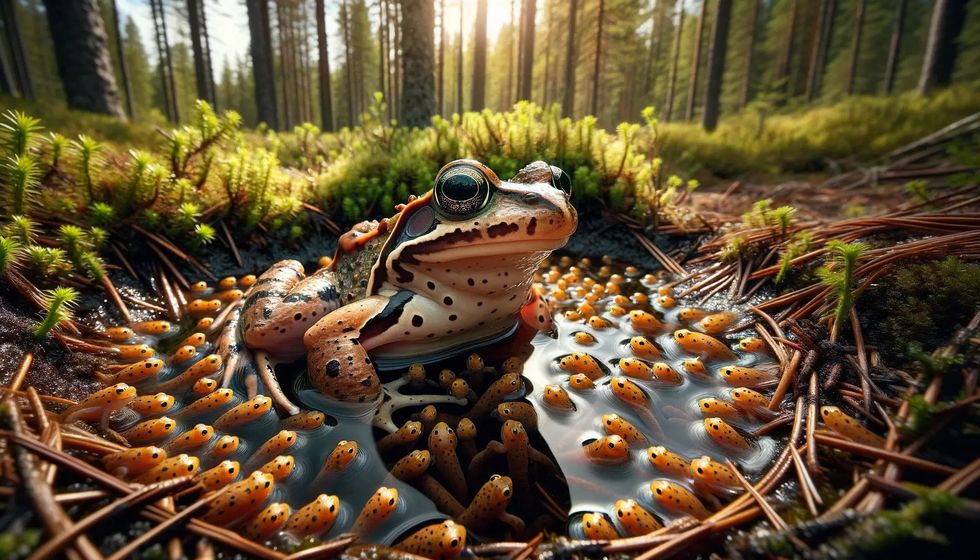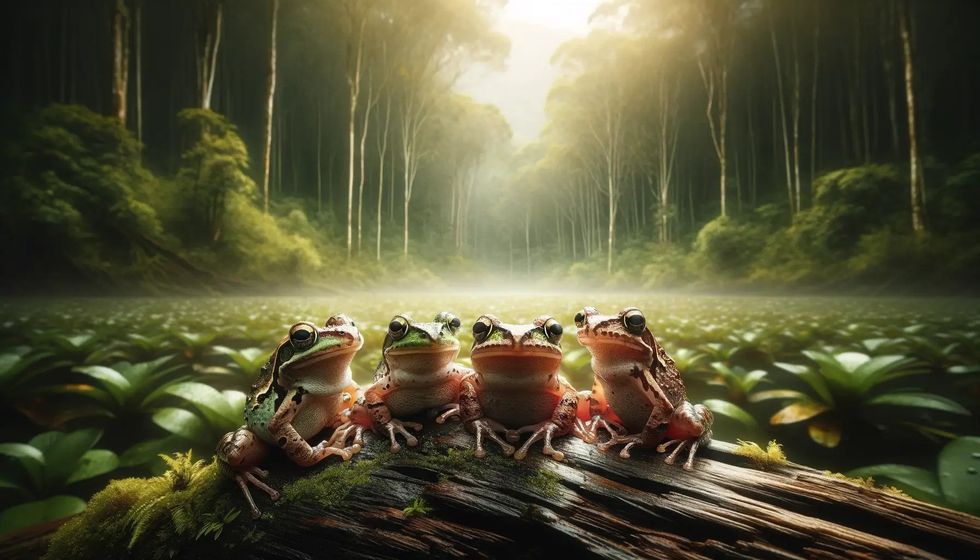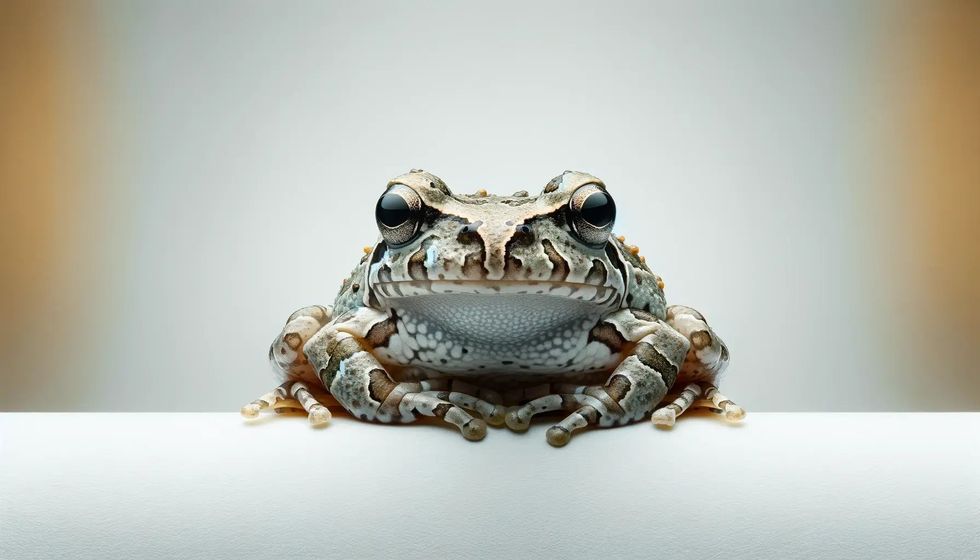Fun Mountain Chorus Frog Facts For Kids
In the peaceful hills and calm waters of West Virginia, the mountain chorus frog, a cousin of the upland chorus frog, makes its home. Part of the larger family of North American chorus frogs, these amazing creatures are a sight to behold when they come out during certain times of the year.
They often gather near pools where they breed, marking the start of the breeding season in late February.
Males come together near breeding pools, making loud calls to attract females and mark the beginning of a new generation. This delightful little frog enchants with its melodic calls, which serve as both beautiful sounds and important contributions to the intricate web of nature.
The calls of this species are unique and easily recognizable. They sound like a comb being run down its bristles, but faster, higher-pitched, and more nasal. This is one of the characteristics that sets it apart from its cousin, the upland chorus frog.
The mountain chorus frog is a small and fascinating creature. It has a unique appearance, with dark stripes on its skin that blend in with its gray or brown color. One interesting feature is the dark triangle between its eyes, which extends down to its upper lip, where there is a white line.
The mountain chorus frog is a truly captivating creature, with beautiful features and amazing behaviors. From its upper lip to its hind legs, this amphibian never fails to amaze.
This species is often confused with the upland chorus frog. It can be found in shallow bodies of water throughout its range, which includes the hillsides of West Virginia and the stretches of the Cumberland Plateau.
The mountain chorus frog, although incredibly fascinating and important for the environment, encounters various obstacles. The beautiful sights and sounds of early spring in Eastern America are at risk due to habitat loss and environmental changes.
This highlights the need for conservation efforts to protect this precious creature. It's important to protect the habitat of the mountain chorus frog, as it is a species of special concern in some states. By doing so, you can help ensure its survival and preserve the natural heritage of the Appalachian region.
Mountain Chorus Frog Interesting Facts

What type of animal is a mountain chorus frog?
A mountain chorus frog is an amphibian.
What class of animal does a mountain chorus frog belong to?
It belongs to the Amphibia class.
How many mountain chorus frogs are there in the world?
The exact numbers are unclear, but they are not considered an endangered species.
Where does a mountain chorus frog live?
This creature lives in Southwestern Pennsylvania, Western Maryland, Southeastern Ohio, Eastern Kentucky, West Virginia, Eastern Tennessee, and northern Alabama, north of the Tennessee River.
What is a mountain chorus frog's habitat?
Its preferred habitats include woodland pools, marshy areas, and sometimes man-made gravel roadsides that form temporary pools.
Who does mountain chorus frog live with?

They gather with other individuals during the breeding season but are otherwise solitary.
How long does a mountain chorus frog live?
Their lifespan in the wild can be up to several years.
How do they reproduce?
They reproduce by laying eggs in water, which hatch into tadpoles before reaching the adult frog form.
What is the Conservation Status of the mountain chorus frog?
It is listed as a Special Concern in certain regions due to habitat challenges.
Mountain Chorus Frog Fun Facts
What do mountain chorus frogs look like?
They are small, with a distinctive dark triangle and white line on their upper lip.
How cute are mountain chorus frogs?
Their small size and striking markings make them quite charming to observers.
How do mountain chorus frogs communicate?

Communication is mainly through their voice, a notable sound that fills the air during their breeding season.
How big is a mountain chorus frog?
They can grow to about 1.5 in (3.81 cm) long.
How fast can a mountain chorus frog run?
They are more talented at leaping than running, especially when navigating their way around pools and vegetation.
How much does a mountain chorus frog weigh?
They are lightweight, typically weighing around 0.2 oz (5 g).
What are the male and female names of the species?
There are no specific names for males and females in this species.
What would you call a baby mountain chorus frog?
A baby mountain chorus frog is called a tadpole.
What do mountain chorus frogs eat?

Their diet consists primarily of small invertebrates, including insects and spiders.
Are mountain chorus frogs poisonous/venomous?
No, mountain chorus frogs are not poisonous or venomous. They do not possess poison that is harmful to humans or larger predators. However, like many amphibians, they may have skin secretions that deter some smaller predators or parasites.
Would a mountain chorus frog make a good pet?
They are better suited to life in the wild, and their habitat needs make them unsuitable as pets.
Did You Know...
Mountain chorus frogs and spring peepers have a special connection. They are known for their lively chorus, which signals the start of spring.
These tiny frogs may not be known for their height, but their compact bodies and low profile make them quite unique.
The mountain chorus frog prefers to be active at night and takes a rest during the day.
The mountain chorus frog's breeding habits are closely connected to the changing weather throughout the year. These frogs are some of the first to wake up from their winter sleep and start making babies, even when there's still ice around their watery homes.
Contrary to what you might think, the mountain chorus frog can be found in various habitats, not just mountains. The habitat range of this creature also includes wooded areas, grassy slopes, and marshy lands. It likes to hang out in shallow, temporary pools of water to breed.
Once the mating is done, the females carefully place their eggs in small groups of 20-50 eggs. They attach these eggs to plants close to the water's edge in the special pond where they breed. In one breeding season, a female can lay multiple clutches of eggs, usually around 300-500 in total.
The mountain chorus frog does not take care of its babies. Once they've finished mating, the males and females make their way back to the land, specifically to areas covered in trees.
During the winter, mountain chorus frogs go into hibernation. They find cozy spots in the leaf litter or soil to stay warm until it's time for them to come out and start breeding.
In the winter, these frogs have a cool trick up their sleeves. They can handle freezing temperatures by making some changes in their bodies that work like natural antifreeze. This helps keep their important organs safe until the weather gets warmer again.
These frogs are important for maintaining a healthy ecosystem by eating insects and helping to control their population.
Adult frogs are just as skilled on land as they are in water. They can make impressive jumps to move around or get away from danger.
The mountain chorus frog doesn't do a lot of climbing, and when it does, it's only into weeds to catch insects.
In some Appalachian communities, the initial chirps of the mountain chorus frogs have long been recognized as a sign to begin planting specific early crops, connecting them directly to local farming traditions.
When mountain chorus frogs are doing well, it's usually a positive sign for the environment. These little frogs have delicate skin and can be affected by pollution.
Mountain chorus frogs have a special way of taking in water and oxygen through their skin, which means they don't have to drink water like other frogs. They can even breathe underwater!
Mountain chorus frogs experience a fascinating transformation called metamorphosis as they progress through their life cycle. After mating, female frogs lay their eggs in groups close to the water's edge in the breeding pond. The eggs hatch about 6-10 days later.
The tadpoles, which are fully aquatic and have gills, spend about 50-60 days living in the pond while they grow.
As tadpoles grow, they also begin to develop little legs at the back. When the tadpole reaches a length of about 0.7 in (1.8 cm), the frog's legs start to grow. As the tadpole grows, its tail gets smaller and smaller until it disappears.
As the frog grows, its lungs start taking over from the gills for breathing. After their lungs are fully developed, the frogs venture out of the water and only go back to the water to find a mate.
FAQs
What are the main threats to the mountain chorus frog?
One of the main dangers that these creatures face is the destruction of their homes caused by urban development, pollution, and climate change. These factors can harm where they breed and their overall survival.
When do mountain chorus frogs tend to be the most active?
They love to be active in the early spring months, especially when it's time for them to breed. During other times, they're not as easy to spot since they prefer to stay hidden under leaves or other hiding spots.
How do mountain chorus frogs handle threats from predators?
These animals have a special way of hiding from their enemies by using their unique colors to blend in with their surroundings. When danger is near, they often use their agility and the darkness to get away.
How do male and female mountain chorus frogs differ?
Males are generally smaller than females and can be distinguished by their darker throats, which are more noticeable during the breeding season. Only males produce the species' characteristic trilling call to attract mates.
Can mountain chorus frogs be confused with toads?
Yes, due to their ground-dwelling habits and bumpy skin texture, mountain chorus frogs can sometimes be mistaken for toads. However, they have smoother skin and longer legs compared to most toad species, and their breeding calls are distinct.
What do mountain chorus frog egg masses look like?
The egg masses of mountain chorus frogs are laid in water and appear as clusters of jelly-like spheres, often attached to underwater vegetation or debris. Each mass contains numerous eggs that will develop into tadpoles.
The mountain chorus frog is a fascinating creature that has a special role in the natural soundscape of North America.
Although they may not be as well-known as the American Bullfrogs or other endangered species, the gentle ripples of their call as tadpoles and the graceful movement of their hind legs in water play a vital role in maintaining the biodiversity of places like the Cumberland Plateau.
The frogs, tadpoles, pools, and vegetative habitats they live in are all part of a delicate balance.
It's important to pay close attention and protect them so that the mountain chorus frogs can thrive for years to come.
We Want Your Photos!
More for You
Bachelor of Science in Mathematics & Computer Science

Ijeoma AsuohaBachelor of Science in Mathematics & Computer Science
Ijeoma is a passionate mathematics and computer science graduate with a penchant for problem-solving and education. Growing up in a large family, she developed a strong sense of responsibility and a love for nurturing young minds. Driven by her natural inclination, Ijeoma often found herself tutoring and mentoring her little cousins and nephews, and She discovered a deep satisfaction in witnessing their growth. Her interactions with her family members sparked a desire to pursue a career where she could combine her technical expertise with her passion for education. Inspired by Kidadl's mission to empower young learners through engaging content, Ijeoma is eager to contribute her skills and knowledge to the team. With her background in mathematics and computer science, coupled with her nurturing nature and teaching experience, she aspires to create impactful educational resources that spark curiosity and inspire learning in children worldwide.
Disclaimer
1) Kidadl is independent and to make our service free to you the reader we are supported by advertising. We hope you love our recommendations for products and services! What we suggest is selected independently by the Kidadl team. If you purchase using the Buy Now button we may earn a small commission. This does not influence our choices. Prices are correct and items are available at the time the article was published but we cannot guarantee that on the time of reading. Please note that Kidadl is a participant in the Amazon Services LLC Associates Program, an affiliate advertising program designed to provide a means for sites to earn advertising fees by advertising and linking to Amazon. We also link to other websites, but are not responsible for their content.
2) At Kidadl, we strive to recommend the very best activities and events. We will always aim to give you accurate information at the date of publication - however, information does change, so it’s important you do your own research, double-check and make the decision that is right for your family. We recognise that not all activities and ideas are appropriate for all children and families or in all circumstances. Our recommended activities are based on age but these are a guide. We recommend that these ideas are used as inspiration, that ideas are undertaken with appropriate adult supervision, and that each adult uses their own discretion and knowledge of their children to consider the safety and suitability. Kidadl cannot accept liability for the execution of these ideas, and parental supervision is advised at all times, as safety is paramount. Anyone using the information provided by Kidadl does so at their own risk and we can not accept liability if things go wrong.
3) Because we are an educational resource, we have quotes and facts about a range of historical and modern figures. We do not endorse the actions of or rhetoric of all the people included in these collections, but we think they are important for growing minds to learn about under the guidance of parents or guardians.







